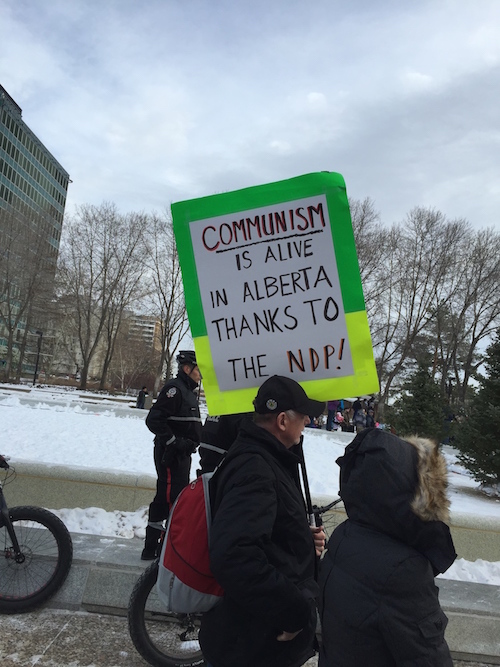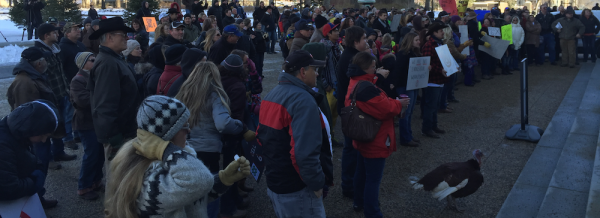Alberta’s NDP government has been in full damage control mode since Bill 6: Enhanced Protection for Farm and Ranch Workers Act exploded in their faces late last month. While attempting to bring our province closer to national standards on farm safety – Alberta is currently the only province without occupation health and safety laws and employment standards coverage for farm and ranch workers – the bill sparked two large protests at the Legislature and continues to bring out thousands of agitated rural Albertans to government-sponsored town-hall style consultation meetings across the province.

Bill 6 has been perceived as a threat to what many rural Albertans see as a traditional way of life and business on the family farm, and inept communications by the government only fuelled claims that this was the intention of the bill.
Taken by surprise, NDP cabinet ministers fanned out to the town hall meetings in an attempt to assure angry rural Albertans that they are listening to their concerns.
While the Wildrose, PC and Alberta Party MLAs have taken positions against Bill 6, the biggest advocate for the bill outside of the mostly silent NDP caucus has been Liberal party interim leader David Swann, a Calgary MLA and former medical officer of health of the now defunct Palliser and Headwaters health authorities in southern Alberta.
Returned from her trip to the Paris Climate Change Conference, Premier Rachel Notley published an open letter to reassure the media and the public that this bill was about farm safety, not about destroying the family farm.
Lori Sigurdson, Minister of Jobs, Employment and Labour, introduced amendments to Bill 6 in the Legislature this week.
The amendments, which “make clear WCB coverage would be required only for paid employees, with an option for farmers to extend coverage to unpaid workers like family members, neighbours and friends” and “make clear that Occupational Health and Safety standards apply when a farm employs one or more paid employees at any time of the year,” appear to address two of the main criticisms of the bill that many opponents and critics (including myself) have raised as concerns.
Aside from legitimate criticisms that rural Albertans were not properly consulted before Bill 6 was introduced into the Legislature, some opponents of the government have tried to spread the kookiest of conspiracy theories about the NDP’s proposed farm safety law.
Over the past week, I have heard claims that Bill 6 would:
- allow the government to nationalize farm land to build solar or wind farms,
- force farm workers to unionize as part of some secret communist conspiracy,
- mark the beginning of a Stalinist farm collectivization program.
None of these outlandish claims are true. But while these claims largely emanate from the anonymity of Twitter and the internet, other oddball claims are actually being made by opposition MLAs.
In the Legislature on Dec. 1, Rick Strankman, the Wildrose MLA for Drumheller-Stettler, suggested that Bill 6 could lead to OHS inspectors confiscating privately owned firearms if they were found to be improperly stored on farms. Mr. Strankman spared fellow MLAs from hearing his best Charlton Heston impersonation.
But perhaps the kookiest of conspiracy theories comes from Progressive Conservative Party interim leader Ric McIver, who is reported to have claimed Bill 6 was part of the NDP plan to turn Alberta into a “Socialist Disneyland.” According to Metro Calgary, Mr. McIver continued in length to praise the conservatism of Saskatchewan, while choosing to omit the fact that our neighbour to the east has a 5 percent provincial sales tax, a 12 percent corporate tax rate, crown corporations for insurance, power and gas, and… farm safety legislation.
Alberta’s NDP government was caught totally off guard by opposition to Bill 6 and has helped fuel the backlash by being slow to react to concerns about changes to farm safety laws. For this, they deserve to be criticized. This is an important lesson for the new government, and one they should recognized as being lucky took place in the first year of their four year term in government, and not six months before the next election.
What’s next?
Bill 6 is currently in second reading in the Legislature.
This will not be the last time the new government will need to challenge the status quo in rural Alberta. The government’s next challenge to rural Alberta will likely be related to province’s longstanding grazing lease program, which the auditor general reports has cost the government an estimated $25 million in annual revenue and is currently under review.
Changes to Alberta’s electoral boundaries, which could be redistributed before the next election to reflect changes in Alberta’s population, would likely result in a reduction of rural constituencies and an increase of urban constituencies in the Alberta Legislature.

